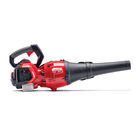Summer is the time of year to be out and enjoying your yard, but all that activity can take a toll, often creating a matted lawn. Fortunately, there are three common ways to repair it: raking, blowing and dethatching.
Raking
Depending on the size of your matted area, raking is quick and easy. It’s best to gently rake matted grass in varied directions to help lift grass and air it out. This also helps to stimulate root growth.
Raking with a flexible plastic- or metal-toothed rake is a great method for post-winter lawn recovery, but it also works well for repairing patches of matted grass. If dead grass is pulled out during raking, remove it to prevent additional matting. If the affected area is severely damaged, apply fertilizer on top of the repair to give soil a rich boost of nutrients.
Blowing
If you have a medium- to large-sized lawn with several matted areas, a leaf blower can help you cover more ground while still lifting the grass to help encourage root growth.
A handheld leaf blower is ideal to repair smaller areas of matted grass. With air speeds ranging from 130 mph up to 205 mph, these blowers can deliver a perfect balance of speed and volume so you can repair the area in a controlled, effective way.
For larger repairs, consider using a wheeled leaf blower. Some models can generate air speed of up to 150 mph with an airflow of up to 1,000 cfm. You may also be able to control the airflow from the handlebars, allowing you to easily start and stop the airflow throughout the process as needed.
Regardless of which type of blower you use, it’s recommended to simply pass over the matted areas of your lawn in various directions as you would with a rake. This method helps fluff your grass and air out any damaged blades. A few passes over your lawn may be needed to ensure a good pull on the affected areas.
Dethatching
If your lawn is more brown than green, you’ll want to dethatch. Thatch results from a buildup of leaves, grass clippings, stems and other vegetation between grass and the soil surface. If thatch continues to grow beneath the surface of your lawn, it can inhibit grass growth and ultimately kill it. Dethatching helps refresh your entire lawn’s root system and creates open passages for air, water and nutrients to reach grass roots.
You should also dethatch after you’ve watered your lawn and mowed at a low height to make it easier to lift grass. Pass over your lawn as you would with your mower. Once you’ve finished, rake and remove scattered grass, and sprinkle lawn sparingly with fertilizer.
After dethatching your lawn, it’s very important to let your grass grow about 3 to 4 inches before mowing again. This will help strengthen its roots.
All three of these repair methods are effective. Make sure to examine the condition of your grass before deciding which one is right for the job so you can continue to enjoy your yard throughout the year.

